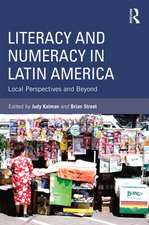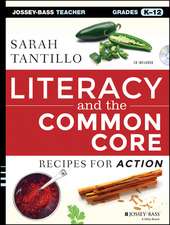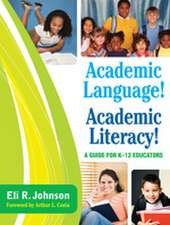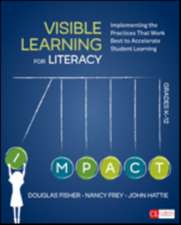No Limits to Literacy for Preschool English Learners
Editat de Theresa A. Robertsen Limba Engleză Paperback – 22 mar 2009
| Toate formatele și edițiile | Preț | Express |
|---|---|---|
| Paperback (1) | 288.38 lei 6-8 săpt. | |
| SAGE Publications – 22 mar 2009 | 288.38 lei 6-8 săpt. | |
| Hardback (1) | 514.98 lei 6-8 săpt. | |
| SAGE Publications – 9 feb 2009 | 514.98 lei 6-8 săpt. |
Preț: 288.38 lei
Nou
Puncte Express: 433
Preț estimativ în valută:
55.19€ • 57.29$ • 46.02£
55.19€ • 57.29$ • 46.02£
Carte tipărită la comandă
Livrare economică 24 martie-07 aprilie
Preluare comenzi: 021 569.72.76
Specificații
ISBN-13: 9781412965644
ISBN-10: 1412965640
Pagini: 264
Dimensiuni: 178 x 254 x 18 mm
Greutate: 0.54 kg
Ediția:1
Editura: SAGE Publications
Colecția Corwin
Locul publicării:Thousand Oaks, United States
ISBN-10: 1412965640
Pagini: 264
Dimensiuni: 178 x 254 x 18 mm
Greutate: 0.54 kg
Ediția:1
Editura: SAGE Publications
Colecția Corwin
Locul publicării:Thousand Oaks, United States
Recenzii
"A well-organized text offering theory and application related to second language instruction. This is a useful tool for any educator to have in his or her resource library."
“This book offers a foundation in language and literacy that greatly benefits dual language learners."
"This welcome and much needed resource for early education professionals is solidly based on the research on early literacy and language development and on Roberts’ extensive and thoughtful experience in effective instructional applications for English learners. The book is written with the clarity to inspire confidence in teachers to translate research evidence and theory into effective and engaging learning activities."
"A powerful contribution to the field of early literacy. Highlighting the quality of the language model as one of the most important resources for language development, Roberts weaves a rich tapestry of research and practical application and helps us understand what this means for embracing our work with ELLs."
“This book offers a foundation in language and literacy that greatly benefits dual language learners."
"This welcome and much needed resource for early education professionals is solidly based on the research on early literacy and language development and on Roberts’ extensive and thoughtful experience in effective instructional applications for English learners. The book is written with the clarity to inspire confidence in teachers to translate research evidence and theory into effective and engaging learning activities."
"A powerful contribution to the field of early literacy. Highlighting the quality of the language model as one of the most important resources for language development, Roberts weaves a rich tapestry of research and practical application and helps us understand what this means for embracing our work with ELLs."
Cuprins
Acknowledgments
About the Author
Introduction
1. Resources English Language Learners Bring to Literacy Learning
The Language and Literacy Wellspring
The Emotional Wellspring
The Motivational Wellspring
The Family Wellspring
The Cultural Wellspring
Conclusion
2. Building On and Scaffolding With Primary Language
Why Support Children's Primary Language?
Primary Language and Literacy Achievement
Adding Some Magic: Metacognitive Benefits
Beyond the Words: Social-Emotional Aspects of Primary Language
What Happens to the Primary Language When Children Enter Preschool?
Using Primary Language for Social Communication and Social-Emotional Purposes
Benefits of Using Primary Language for Literacy Learning
Primary Language Resources
Practices for Supporting Primary Language at Home
Different Primary Language Programs
Spending "Time on Task" in English
Patience in Achieving Bilingualism
Conclusion
3. Oral Language Development in a Second Language
Second Language Learning in Naturalistic Settings
Second Language Learning in Preschool Settings
Examining the Silent or Receptive Stage in Second Language Acquisition
Learning About Language Acquisition From Caregivers
Cultural Variations in Caregiver Speech and a Challenge for Educators
Language for Basic Communication and Academic Learning
How Children Learn the Meaning of Words
Learning Words From Instruction
The Relationship Between Oral Language and Second Language Literacy
Classroom Contexts for Language Development
The Wonder and Limits of Storybook Reading
Conversations With Children
Language Development During Center Time
Talking-Up Routines and Transitions
Mealtime Opportunities for Talking
Language and Literacy Enhanced Play
Teacher Oral Language: An Elephant in the Room
Home Influences on Second Language Learning
Conclusion
4. Befriending the Alphabet: Why and How
Can Children With Limited Knowledge of English Learn the English Alphabet?
Why Explicit Instruction Is Beneficial
Going Deeper Into the Alphabet
Should Letter Names or Letter Sounds be Taught First?
How Should the Uppercase and Lowercase Letters be Taught?
Learning Personal Names
Making the Connection Between Letters and Meaningful Printed Words
Writing Helps Children Learn the Alphabet
Teaching the Alphabet in a Language Other Than English
How Much Letter Instruction Is Needed?
Conclusion
5. Sounds in Words: Phonological Awareness
What is Phonological Awareness?
Words: The Foundation of Phonological Awareness
Unnatural Aspects of Phonological Awareness
Preschool Phonological Awareness and Later Reading
Can Preschool Children Learn Phonological Awareness?
Connections Between L1 and L2 Phonological Awareness
Learning Phonological Awareness in a Second Language
The Joined Hands of Vocabulary and the Alphabet
Does Second Language Pronunciation Matter?
How Much Phonological Awareness Do Preschool English Learners Need?
What's Up With Rhyming?
Making Sounds Stand Still and Be Concrete
The Language Used in Phonological Awareness Instruction
Conclusion
6. Curriculum, Instruction, and Literacy Activity
Essential Elements of an Effective Curriculum
An Articulated Curriculum
Matching Goals With Teaching Strategies/Activities
The Language of Instruction
Building Relationships While Fostering Literacy
Teachers' Support and Instructional Roles
The Value of Small Groups and One-one-One Teaching
Increasing Opportunities for Teachers' Support Role
The Language of Relationship Building
The Benefits of Explicit Instruction
High-Quality Teaching and Learning
Child Choice and Literacy Instruction
Using Assessment to Benefit Children
Teachers: The Critical Ingredient
Program and Instruction Evaluations
Challenges for Moving Forward
Conclusion
7. Engaging Family Caregivers
Create an Alliance
Focus on Language and Literacy
Thinking Processes and Positive Relationships Working Together
Home Emotional Support for Literacy
Home Cognitive Support for Literacy
Family Responsive and Family Tailored Approaches
Teacher Influences on Family Engagement
Family Caregivers and Children Reading Together
Family Caregivers and Children Playfully Solving Problems Together
Engaging Family Caregivers in the Classroom
One Model for Engaging Families
High-Quality Family Engagement Practices
Conclusion
8. Motivation for Literacy
Characteristics of Motivated Children
Are All Preschool Children Highly Motivated for Literacy?
Linkages Between Preschool Motivation and Later Reading
The Need for Competence and Mastery-Inside Every Child
Effectance Motivation Theory Moves Forward
The Motivational Link Between Thinking and Emotion
Mastery and Performance Orientations
Three Motivational Needs (Competence, Autonomy, Relatedness)
The Compatibility of Autonomy and Structure
The Special Worry of Failure
Does Explicit Instruction Undermine Motivation?
Culture, Language and Motivation for Literacy
The Language of Motivation
Home Influences on Language and Literacy Motivation
Conclusion
References
Index
About the Author
Introduction
1. Resources English Language Learners Bring to Literacy Learning
The Language and Literacy Wellspring
The Emotional Wellspring
The Motivational Wellspring
The Family Wellspring
The Cultural Wellspring
Conclusion
2. Building On and Scaffolding With Primary Language
Why Support Children's Primary Language?
Primary Language and Literacy Achievement
Adding Some Magic: Metacognitive Benefits
Beyond the Words: Social-Emotional Aspects of Primary Language
What Happens to the Primary Language When Children Enter Preschool?
Using Primary Language for Social Communication and Social-Emotional Purposes
Benefits of Using Primary Language for Literacy Learning
Primary Language Resources
Practices for Supporting Primary Language at Home
Different Primary Language Programs
Spending "Time on Task" in English
Patience in Achieving Bilingualism
Conclusion
3. Oral Language Development in a Second Language
Second Language Learning in Naturalistic Settings
Second Language Learning in Preschool Settings
Examining the Silent or Receptive Stage in Second Language Acquisition
Learning About Language Acquisition From Caregivers
Cultural Variations in Caregiver Speech and a Challenge for Educators
Language for Basic Communication and Academic Learning
How Children Learn the Meaning of Words
Learning Words From Instruction
The Relationship Between Oral Language and Second Language Literacy
Classroom Contexts for Language Development
The Wonder and Limits of Storybook Reading
Conversations With Children
Language Development During Center Time
Talking-Up Routines and Transitions
Mealtime Opportunities for Talking
Language and Literacy Enhanced Play
Teacher Oral Language: An Elephant in the Room
Home Influences on Second Language Learning
Conclusion
4. Befriending the Alphabet: Why and How
Can Children With Limited Knowledge of English Learn the English Alphabet?
Why Explicit Instruction Is Beneficial
Going Deeper Into the Alphabet
Should Letter Names or Letter Sounds be Taught First?
How Should the Uppercase and Lowercase Letters be Taught?
Learning Personal Names
Making the Connection Between Letters and Meaningful Printed Words
Writing Helps Children Learn the Alphabet
Teaching the Alphabet in a Language Other Than English
How Much Letter Instruction Is Needed?
Conclusion
5. Sounds in Words: Phonological Awareness
What is Phonological Awareness?
Words: The Foundation of Phonological Awareness
Unnatural Aspects of Phonological Awareness
Preschool Phonological Awareness and Later Reading
Can Preschool Children Learn Phonological Awareness?
Connections Between L1 and L2 Phonological Awareness
Learning Phonological Awareness in a Second Language
The Joined Hands of Vocabulary and the Alphabet
Does Second Language Pronunciation Matter?
How Much Phonological Awareness Do Preschool English Learners Need?
What's Up With Rhyming?
Making Sounds Stand Still and Be Concrete
The Language Used in Phonological Awareness Instruction
Conclusion
6. Curriculum, Instruction, and Literacy Activity
Essential Elements of an Effective Curriculum
An Articulated Curriculum
Matching Goals With Teaching Strategies/Activities
The Language of Instruction
Building Relationships While Fostering Literacy
Teachers' Support and Instructional Roles
The Value of Small Groups and One-one-One Teaching
Increasing Opportunities for Teachers' Support Role
The Language of Relationship Building
The Benefits of Explicit Instruction
High-Quality Teaching and Learning
Child Choice and Literacy Instruction
Using Assessment to Benefit Children
Teachers: The Critical Ingredient
Program and Instruction Evaluations
Challenges for Moving Forward
Conclusion
7. Engaging Family Caregivers
Create an Alliance
Focus on Language and Literacy
Thinking Processes and Positive Relationships Working Together
Home Emotional Support for Literacy
Home Cognitive Support for Literacy
Family Responsive and Family Tailored Approaches
Teacher Influences on Family Engagement
Family Caregivers and Children Reading Together
Family Caregivers and Children Playfully Solving Problems Together
Engaging Family Caregivers in the Classroom
One Model for Engaging Families
High-Quality Family Engagement Practices
Conclusion
8. Motivation for Literacy
Characteristics of Motivated Children
Are All Preschool Children Highly Motivated for Literacy?
Linkages Between Preschool Motivation and Later Reading
The Need for Competence and Mastery-Inside Every Child
Effectance Motivation Theory Moves Forward
The Motivational Link Between Thinking and Emotion
Mastery and Performance Orientations
Three Motivational Needs (Competence, Autonomy, Relatedness)
The Compatibility of Autonomy and Structure
The Special Worry of Failure
Does Explicit Instruction Undermine Motivation?
Culture, Language and Motivation for Literacy
The Language of Motivation
Home Influences on Language and Literacy Motivation
Conclusion
References
Index
Descriere
Combining theory with proven teaching strategies, this resource helps preschool educators produce strong language and literacy outcomes for English learners ages 3 to 5.









